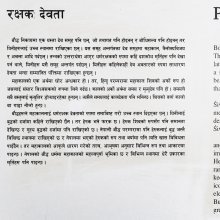Kahi, Kahī: 10 definitions
Introduction:
Kahi means something in Hinduism, Sanskrit, Marathi, Jainism, Prakrit, Hindi, biology. If you want to know the exact meaning, history, etymology or English translation of this term then check out the descriptions on this page. Add your comment or reference to a book if you want to contribute to this summary article.
Images (photo gallery)
Biology (plants and animals)
Source: Google Books: CRC World Dictionary (Regional names)1) Kahi in India is the name of a plant defined with Saccharum spontaneum in various botanical sources. This page contains potential references in Ayurveda, modern medicine, and other folk traditions or local practices It has the synonym Imperata spontanea (L.) P. Beauv. ex Roem. & Schult., nom. illeg., non Imperata spontanea (L.) P. Beauv. (among others).
2) Kahi in Nigeria is also identified with Khaya senegalensis It has the synonym Swietenia senegalensis Desv. (etc.).
Example references for further research on medicinal uses or toxicity (see latin names for full list):
· Voyage autour du Monde (1829)
· Caryologia (1984)
· Annals of the Missouri Botanical Garden (1994)
· Systema Vegetabilium (1817)
· Mémoires du Muséum d’Histoire Naturelle (1830)
· Flora AegyptiacoArabica (1775)
If you are looking for specific details regarding Kahi, for example extract dosage, side effects, chemical composition, health benefits, pregnancy safety, diet and recipes, have a look at these references.

This sections includes definitions from the five kingdoms of living things: Animals, Plants, Fungi, Protists and Monera. It will include both the official binomial nomenclature (scientific names usually in Latin) as well as regional spellings and variants.
Languages of India and abroad
Marathi-English dictionary
Source: DDSA: The Molesworth Marathi and English Dictionarykahī (कही).—f ( H) A foraging party.
Source: DDSA: The Aryabhusan school dictionary, Marathi-Englishkahī (कही).—f A foraging party.
Marathi is an Indo-European language having over 70 million native speakers people in (predominantly) Maharashtra India. Marathi, like many other Indo-Aryan languages, evolved from early forms of Prakrit, which itself is a subset of Sanskrit, one of the most ancient languages of the world.
Sanskrit dictionary
Source: Cologne Digital Sanskrit Dictionaries: Edgerton Buddhist Hybrid Sanskrit DictionaryKahi (कहि) or Kahiṃ.—(cit) , as loc. of ka-, see § 21.22; some-times varies in mss. with karhi.
Source: Cologne Digital Sanskrit Dictionaries: Monier-Williams Sanskrit-English DictionaryKāhī (काही):—f. the plant Wrightia antidysenterica, [cf. Lexicographers, esp. such as amarasiṃha, halāyudha, hemacandra, etc.]
[Sanskrit to German]
Sanskrit, also spelled संस्कृतम् (saṃskṛtam), is an ancient language of India commonly seen as the grandmother of the Indo-European language family (even English!). Closely allied with Prakrit and Pali, Sanskrit is more exhaustive in both grammar and terms and has the most extensive collection of literature in the world, greatly surpassing its sister-languages Greek and Latin.
Hindi dictionary
Source: DDSA: A practical Hindi-English dictionaryKāhī (काही):—(a) blackish green, of the colour of moss; jealous.
...
Prakrit-English dictionary
Source: DDSA: Paia-sadda-mahannavo; a comprehensive Prakrit Hindi dictionaryKahi (कहि) in the Prakrit language is related to the Sanskrit words: Kva, Kutra.
Kahi has the following synonyms: Kahiā, Kahiṃ.
Prakrit is an ancient language closely associated with both Pali and Sanskrit. Jain literature is often composed in this language or sub-dialects, such as the Agamas and their commentaries which are written in Ardhamagadhi and Maharashtri Prakrit. The earliest extant texts can be dated to as early as the 4th century BCE although core portions might be older.
Kannada-English dictionary
Source: Alar: Kannada-English corpusKahi (ಕಹಿ):—[adjective] designating or having a sharp, often unpleasant taste; acrid, as bitter gourd, neem leaves,etc. bitter.
--- OR ---
Kahi (ಕಹಿ):—[noun] the taste or flavour of neem leaves or bitter gourd; bitterness; acridity.
--- OR ---
Kahi (ಕಹಿ):—[verb] to become bitter, acrid.
--- OR ---
Kāhi (ಕಾಹಿ):—[noun] a man who tends, protects, watches, etc.
Kannada is a Dravidian language (as opposed to the Indo-European language family) mainly spoken in the southwestern region of India.
See also (Relevant definitions)
Starts with (+44): Kahi baevu, Kahi bevu, Kahi jeerige, Kahi kanchi, Kahi nimba, Kahi sunde, Kahia, Kahiban, Kahibevu, Kahibrahmi, Kahicakkota, Kahidomde, Kahiga, Kahihagalu, Kahihale, Kahiharu, Kahihire, Kahihireya-balli, Kahihullu, Kahiidana.
Ends with: Kakahi, Kulikahi, Laukahi, Makahi.
Full-text (+11): Kahim, Kva, Kutra, Kahia, Kahiku, Kahi baevu, Kahi bevu, Kahiga, Kahi jeerige, Kahi kanchi, Kahi sunde, Kahi nimba, Kahinka, Bajata, Kayisore, Baki, Kahin, Prabhuta, Tirtha, Tittha.
Relevant text
Search found 8 books and stories containing Kahi, Kahī, Kāhī, Kāhi; (plurals include: Kahis, Kahīs, Kāhīs, Kāhis). You can also click to the full overview containing English textual excerpts. Below are direct links for the most relevant articles:
Chaitanya Bhagavata (by Bhumipati Dāsa)
Verse 2.6.14 < [Chapter 6 - The Lord’s Meeting with Advaita Ācārya]
Verse 2.10.128 < [Chapter 10 - Conclusion of the Lord’s Mahā-prakāśa Pastimes]
Verse 1.5.163 < [Chapter 5 - Eating the Mendicant Brāhmaṇa’s Offerings]
Bhajana-Rahasya (by Srila Bhaktivinoda Thakura Mahasaya)
Text 17 < [Chapter 5 - Pañcama-yāma-sādhana (Aparāhna-kālīya-bhajana–kṛṣṇa-āsakti)]
Text 1 < [Chapter 1 - Prathama-yāma-sādhana (Niśānta-bhajana–śraddhā)]
Bhakti-rasamrta-sindhu (by Śrīla Rūpa Gosvāmī)
Shri Gaudiya Kanthahara (by Srila Bhaktisiddhanta Sarasvati)
Folk Tales of Gujarat (and Jhaverchand Meghani) (by Vandana P. Soni)
Aspects of Hindi Literature < [October 1956]
